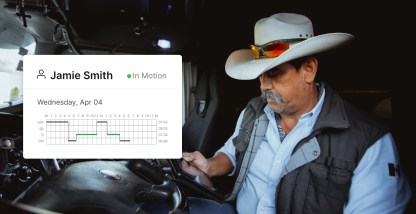The Canadian government recently announced plans to publish legislation similar to the FMCSA’s ELD mandate, which requires drivers who currently keep a Record of Duty Status (RODS) to switch from paper logs to an electronic logging device. Few technical details regarding the device have been released, but the Canadian government hopes to implement a timeline similar to the US, which requires drivers to adopt ELDs by January 1, 2023.
3 reasons for Canadian fleets to adopt ELDs early
1. Time constraints
The Canada ELD mandate rules will go into full effect beginning January 1, 2023. Waiting to find an ELD solution could leave your fleet out-of-service due to a market overload from drivers and fleets rushing to purchase ELDs last minute.
2. Drivers operating in the U.S. will require ELDs
Operating a commercial motor vehicle south of the border will be required to follow U.S. hours-of-service rules and regulations. If your carrier is based in Canada, but makes cross-border deliveries, you will be required to have an ELD solution by the January 1, 2023 deadline.
3. Not all ELD providers are alike
There are many ELD providers. With so many options, it’s important to find a solution that supports both Canadian and U.S. HOS rules, and that also provides your fleets tools to streamline fleet management operations.
5 factors to consider when selecting an ELD provider
1. Upfront hardware costs
Make sure that you are aware of all the upfront hardware costs before selecting an ELD provider.
Many companies charge a baseline fee for ELD hardware on top of installation, training, and monthly costs. However, some providers offer hardware for free because their systems leverage a driver’s smartphone, which can greatly reduce the bottom line — while keeping drivers compliant with the Canada ELD mandate rules.
Based on your budget constraints, you might want to select an ELD provider that doesn’t charge for hardware.
2. Ease of use
If your drivers can’t figure out the ELD system in 10 minutes or less, you’re in for a headache. Look for public reviews of electronic logs that drivers genuinely like. It will make the transition easier for you.
3. ELD-smartphone pairing
According to the ELD mandate (which is expected to be very similar to future Canadian legislation), electronic logging devices that pair with smartphones and/or tablets are FMCSA compliant. The ELD hardware must connect directly to the truck’s engine, but the smartphone or tablet can wirelessly sync with the ELD to automatically record information collected from the engine.
Make sure that the ELD provider you’re going with offers this syncing option.
4. Installation fees
Implementation fees often account for the majority of hidden ELD costs. Some companies charge over $1,000 and require professional installation. Not only does this drive up the price of an ELD, but it could also mean waiting months before you actually get your device installed.
5. Long-term compliance
Some vendors sell AOBRDs or EOBRs, which were designed for 1988 FMCSA rules. They’re often masked as ELDs, but in 2019 these won’t be compliant in the United States. Make sure your provider is selling an FMCSA-registered ELD to ensure DOT compliance. In Canada, you’ll need to ensure that your ELD is certified to meet Canada ELD mandate rules.
Learn more about Canada ELD mandate rules. And, contact a Motive sales rep to get started with a Canadian-certified ELD today.







